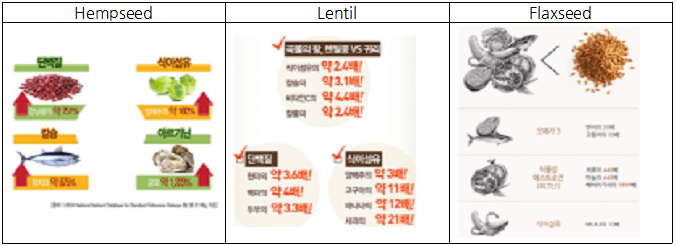KCA News & Media
Press Release
Press Release
| Need Attention for Excessive Intake of Flaxseed | |||||||||
|---|---|---|---|---|---|---|---|---|---|
| Date | 2017-03-17 | Hit | 1614 | ||||||
|
Need Attention for Excessive Intake of Flaxseed
- No big difference major ingredients of local and imported whole grains -
The recent imported grains(lentils, flaxseeds and hempseeds etc) so called “Super food” are gaining popularity among consumers, but there is lack of safety and nutrition information.
The Korea Customer Agency(President Han Kyeon-pyo, KCA) reflected the Government 3.0 core value to conduct safety examination of 42 of 8 types of grains(30 imported products, 12 local products) and to compare and analyze the major nutrition of fungal toxin, pesticide residue.
* 30 imported products (6 lentils, 6 flaxseeds, 6 quinoas, 6 hempseeds), 12 local products(4 perilla, 4 green flesh black bean, 4 sorghum)
□ Caution for no excessive intake of flaxseed
Flaxseeds among imported grains (5 types of 30) contain cyanogen glycoside so its usage is limited in accordance with “standard of food”, Article 7, Food Sanitation Act. In addition, flaxseeds need heat treatment and its daily consumption is limited(4g once, less than 16g per da). However, some flaxseeds don’t comply with defined amount of intake, which draws attention from customers.
* Cyanogen glycoside: Cyanogen glycoside itself is not harmful but is decomposed by enzyme to create HCN, which could cause cyanoderma. Therefore, it requires enzymatic deactivation through heat treatment.
** Limitation of intake: The daily intake should not go over 16g for enzymatic deactivation and the daily amount should not exceed 4g.
※ Cyanoderma is that your skin and mucous membrane become blue to increase reduced hemoglobin in small vessels, which lowers oxygen saturation. As a result, your body gets blue.
[Labeling examples of intake of flaxseed]
[Advertisements for flaxseed]
There is a concern about excessive intake of flaxseeds as it can go with other food and multi-grain rice. Therefore, labeling of amount of intake is mandatory and consumers should follow the proper content.
□ Cadmium(0.246~0.560㎎/㎏) was found in all 6 products
Heavy metals(lead, cadmium) were found in 30 out of 42 products. The content of cadmium turned out to be higher than other grains in flaxseeds in 6 products. Lentils, green flesh black beans, Sorghum, chia seeds and quinoas contained heavy metals. But their amount was very small.
* Cadmium is harmful to our body and can be exposed through food, drinking water and soil. Its repetitive exposure can cause lung damage and itai-iai disease.
□ No big difference major ingredients of local and imported whole grains
It turned out that there is no huge difference in major nutrition of the same types of grains whether local or imported. The nutrition content was 24kg of protein of local green flesh black beans, 17g of dietary fiber, 27g protein of imported lentils, 12g of dietary fiber. The content of omega fatty acid in imported flaxseeds was 25, highest among others but, no difference was found when compared with local perilla(22g)
However, consumers are likely to get wrong information that imported nutrition is better than local one due to false advertisements.
[Advertising cases of sales of imported grains]
Therefore, consumers need to make resonable choice when they buy grains with objective information of nutrition, physical constitution and price.
The KCA is scheduled to ask the Ministry of Food and Drug Safety ▲for setting standards for cadmium and ▲for mandatory labeling of contents of the same products for the safety of flaxseeds. The agency requested consumers ▲not to take excessive intake of flaxseeds and to do reasonable consumption. |
|||||||||
| Next | Korea Consumer Agency’s President Participating in G20 Consumer Summit | ||||||||
| Prev | Recall and No Sale of Hair Mist found in CMIT/MIT | ||||||||



